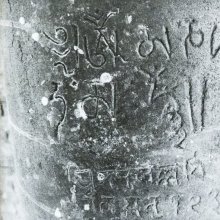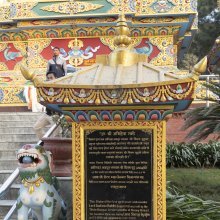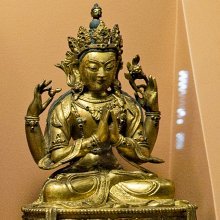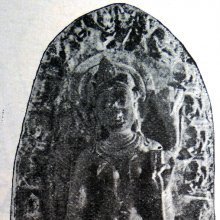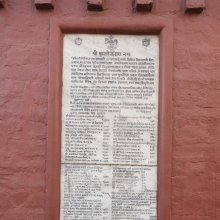Om, Oṃ: 22 definitions
Introduction:
Om means something in Buddhism, Pali, Hinduism, Sanskrit, the history of ancient India, Marathi, Hindi, biology, Tamil. If you want to know the exact meaning, history, etymology or English translation of this term then check out the descriptions on this page. Add your comment or reference to a book if you want to contribute to this summary article.
Images (photo gallery)
(+22 more images available)
In Hinduism
Shaivism (Shaiva philosophy)
Source: Wisdom Library: ŚaivismOṃ (ओं) is the tradition (ovallī) founded by Guḍikanātha, who was one of the twelve princes born to Kuṃkumā, consort to Mīnanātha, who is the incarnation of Siddhanātha in the fourth yuga, belonging to the Pūrvāmnāya (‘eastern doctrine’) tradition of Kula Śaivism, according to the Ciñcinīmatasārasamuccaya. Siddhanātha incarnates as a Kaula master in each of the four yugas. Guḍikanātha was one of the six princes having the authority to teach.

Shaiva (शैव, śaiva) or Shaivism (śaivism) represents a tradition of Hinduism worshiping Shiva as the supreme being. Closely related to Shaktism, Shaiva literature includes a range of scriptures, including Tantras, while the root of this tradition may be traced back to the ancient Vedas.
Vyakarana (Sanskrit grammar)
Source: Wikisource: A dictionary of Sanskrit grammarOm (ओम्).—See ओंकार (oṃkāra) above-ओम् (om) consists of 2 1/2 matras, cf. अर्धतृतीयमात्र एके ब्रुवते (ardhatṛtīyamātra eke bruvate) T. Pr 18.1; शैत्यायन (śaityāyana) says that ओम् (om) has any one of the three accemts, while कौण्डिन्य (kauṇḍinya) says it has प्रचय (pracaya) or एकश्रुति (ekaśruti) i. e. absence of any accent.

Vyakarana (व्याकरण, vyākaraṇa) refers to Sanskrit grammar and represents one of the six additional sciences (vedanga) to be studied along with the Vedas. Vyakarana concerns itself with the rules of Sanskrit grammar and linguistic analysis in order to establish the correct context of words and sentences.
Purana and Itihasa (epic history)
Source: archive.org: Puranic EncyclopediaOm (ओम्).—This sound is a combination of the three letters-A, U and M. The A—sound signifies Viṣṇu, the U-sound signifies Śiva and the M—sound signifies Brahmā.
"akāro viṣṇuruddiṣṭa ukārastu maheśvaraḥ / makārastu smṛto brahmā praṇavastu trayātmakaḥ // (vāyu purāṇa)."
The sound "Om" is called "Praṇava" or "Brahman." All mantras begin with the sound 'Om'. Because of its sacredness, Śūdras and other low-caste people are not allowed to utter it or to hear it. They may pronounce it only as "Aum." This sound includes all that has happened and all that is to happen. (Māṇḍūkyopaniṣad).

The Purana (पुराण, purāṇas) refers to Sanskrit literature preserving ancient India’s vast cultural history, including historical legends, religious ceremonies, various arts and sciences. The eighteen mahapuranas total over 400,000 shlokas (metrical couplets) and date to at least several centuries BCE.
Ganapatya (worship of Ganesha)
Source: om.ru: Ashtavinayak (8 temples of Ganesha)OM is the symbol for Brahman, or the universal soul. The elephant’s head represents superior intelligence, while the snake around the waist represents cosmic energy. The noose (pasha) should remind us that all worldly attachments are bonds, the hook (ankush), often depicted in his hand, should guide us on the path of righteousness, the broken fang of Ganesha, with which the Mahabharata was written, symbolizes knowledge, modak (sweetness ) in his hand reminds us of the sweetness of our inner self.
Ganapatya (गाणपत्य, gāṇapatya) represents a tradition of Hinduism where Ganesha is revered and worshipped as the prime deity (ishta-devata). Being a minor though influential movement, Ganapatya evovled, llike Shaktism and Shaivism, as a separate movement leaving behind a large body of literature.
General definition (in Hinduism)
Source: WikiPedia: HinduismOm , or Aum (ॐ): the most sacred syllable in Hinduism, first coming to light in the Vedic Tradition. The syllable is sometimes referred to as the "Udgitha" or "pranava mantra" (primordial mantra); not only because it is considered to be the primal sound, but also because most mantras begin with it.
Source: Shodhganga: The significance of the mūla-berasOṃ (ओं), the fundamental sound and the origin of all other sounds. The written form of the Oṃ sound in Tamil is similar to the face of Vināyaka. Oṃ stands for the absolute substance, the entire universe, and the essence of all Vedas. Oṃ is the Brahman from which all creation begins and into which all return. [...] Vināyaka is thus compared to the praṇava -mantra Oṃ. As Oṃ stands for the Brahman from which all creation begins, Vināyaka is also worshipped first in temples by the devotees.
The sound Oṃ comprises three syllables–a, u and m where a sound signifies conception (Brahmā) the u sound existence (Viṣṇu) and the m sound dissolution (Śiva). Oṃ also stands for wind, fire and the sun, as well as for the past, present and future. Keeping all these philosophical significances, the sculptor has visualized a form to represent the written word Oṃ. The curve of the letter represent the head and the face of the elephant; starting with the broken tusk on the left side over the broad elephant’s head, curving downward into the unbroken tusk following the trunk to the end in a circle at the tip of the trunk, in which a round modaka is placed, becomes the letter m in Tamil.
In Buddhism
Tibetan Buddhism (Vajrayana or tantric Buddhism)
Source: OSU Press: Cakrasamvara Samadhi1) Oṃ (ओं) is the bīja associated with Oḍiyāna, according to the Cakrasaṃvara-maṇḍala or Saṃvaramaṇḍala of Abhayākaragupta’s Niṣpannayogāvalī, p. 45 and n. 145; (Cf. Cakrasaṃvaratantra, Gray, David B., 2007).—The Cakrasaṃvara mandala has a total of sixty-two deities. [...] Three concentric circles going outward, the body, speech and mind wheels (kāya-vāka-citta), in the order: mind (blue), speech (red), and body (white), with eight Ḍākinīs each in non-dual union with their Ḍākas, "male consorts".
Associated elements of Prabhāmatī and Kaṅkāla:
Circle: kāyacakra (mind-wheel) (blue);
Ḍākinī (female consort): Prabhāmatī;
Ḍāka (male consort): Kaṅkāla;
Bīja: oṃ;
Body-part: right ear;
Pīṭha: Oḍiyāna;
Bodily constituent: tvaṅ-mala (skin/filth);
Bodhipakṣa (wings of enlightenment): mīmāṃsā-ṛddhipāda (power of analysis).
2) Oṃ (ओं) is also associated with Oḍra, Mahābhairavā and Vajrajaṭila:
Circle: vākacakra [=vākcakra?] (speech-wheel) (red);
Ḍākinī (female consort): Mahābhairavā;
Ḍāka (male consort): Vajrajaṭila;
Bīja: oṃ;
Body-part: breasts;
Pīṭha: Oḍra;
Bodily constituent: pitta (bile);
Bodhipakṣa (wings of enlightenment): śraddhābala (power of conviction).

Tibetan Buddhism includes schools such as Nyingma, Kadampa, Kagyu and Gelug. Their primary canon of literature is divided in two broad categories: The Kangyur, which consists of Buddha’s words, and the Tengyur, which includes commentaries from various sources. Esotericism and tantra techniques (vajrayāna) are collected indepently.
General definition (in Buddhism)
Source: Buddhist Door: GlossaryThe most simple, yet sacred mantra in Buddhism, also used in other Indian religions.India history and geography
Source: Cologne Digital Sanskrit Dictionaries: Indian Epigraphical GlossaryOm.—the praṇava sometimes found at the commencement of inscriptions; often represented by a sign which should not be con- fused with the symbol standing for the auspicious word siddham. Note: om is defined in the “Indian epigraphical glossary” as it can be found on ancient inscriptions commonly written in Sanskrit, Prakrit or Dravidian languages.

The history of India traces the identification of countries, villages, towns and other regions of India, as well as mythology, zoology, royal dynasties, rulers, tribes, local festivities and traditions and regional languages. Ancient India enjoyed religious freedom and encourages the path of Dharma, a concept common to Buddhism, Hinduism, and Jainism.
Biology (plants and animals)
Source: Google Books: CRC World Dictionary (Regional names)1) Om in Guatemala is the name of a plant defined with Ipomoea batatas in various botanical sources. This page contains potential references in Ayurveda, modern medicine, and other folk traditions or local practices It has the synonym Convolvulus denticulatus Desr. (among others).
2) Om in Thailand is also identified with Pogostemon benghalensis It has the synonym Origanum benghalense Burm.f. (etc.).
3) Om is also identified with Pogostemon plectrantoides It has the synonym Mentha secunda Roxb. (etc.).
Example references for further research on medicinal uses or toxicity (see latin names for full list):
· Bull. Acad. Bruxelles (1845)
· Flora de Filipinas (1837)
· Acta Agronomica Sinica (1998)
· Species Plantarum (1753)
· Gardeners Dictionary, ed. 8 (1768)
· Nova Genera et Species Plantarum (1818)
If you are looking for specific details regarding Om, for example pregnancy safety, side effects, health benefits, diet and recipes, chemical composition, extract dosage, have a look at these references.

This sections includes definitions from the five kingdoms of living things: Animals, Plants, Fungi, Protists and Monera. It will include both the official binomial nomenclature (scientific names usually in Latin) as well as regional spellings and variants.
Languages of India and abroad
Marathi-English dictionary
Source: DDSA: The Molesworth Marathi and English Dictionaryōm (ओम्).—ind S The mystic name of the Deity prefacing all the prayers of the Hindus. It is formed of a A name of viṣṇu, u of śiva, & ma of brahmā.
Marathi is an Indo-European language having over 70 million native speakers people in (predominantly) Maharashtra India. Marathi, like many other Indo-Aryan languages, evolved from early forms of Prakrit, which itself is a subset of Sanskrit, one of the most ancient languages of the world.
Sanskrit dictionary
Source: DDSA: The practical Sanskrit-English dictionaryOm (ओम्).—ind.
1) The sacred syllable om, uttered as a holy exclamation at the beginning and end of a reading of the Vedas, or previous to the commencement of a prayer or sacred work.
2) As a particle it implies (a) solemn affirmation and respectful assent (so be it, amen !); (b) assent or acceptance (yes, all right); ओमित्युच्यताममात्यः (omityucyatāmamātyaḥ) Mālatīmādhava (Bombay) 6; ओमित्युक्तवतोऽथ शार्ङ्गिण इति (omityuktavato'tha śārṅgiṇa iti) Śi. 1.75; द्वितीयश्चेदोमिति ब्रूमः (dvitīyaścedomiti brūmaḥ) S. D.1; (c) command; (d) auspiciousness; (e) removal or warding off.
3) Brahman. [This word first appears in the Upaniṣads as a mystic monosyllable, and is regarded as the object of the most profound religious meditation. In the Maṇḍūkya Upaniṣad it is said that this syllable is all what has been, that which is and is to be; that all is om, only om. Literally analysed, om is taken to be made up of three letters or quarters; the letter a is Vaiśvānara, the spirit of waking souls in the waking world; u is Taijasa, the spirit of dreaming souls in the world of dreams; and m is Prajñā, the spirit of sleeping and undreaming souls; and the whole om is said to be unknowable, unspeakable, into which the whole world passes away, blessed above duality; (for further account see Gough's Upaniṣads pp.69-73). In later times om came to be used as a mystic name for the Hindu triad, representing the union of the three gods a (Viṣṇu), u (Śiva), and m (Brahmā). It is usually called Praṇava or Ekakṣaram; cf. अकारो विष्णुरुद्दिष्ट उकारस्तु महेश्वरः । मकारेणोच्यते ब्रह्मा प्रणवेन त्रयो मताः (akāro viṣṇuruddiṣṭa ukārastu maheśvaraḥ | makāreṇocyate brahmā praṇavena trayo matāḥ) ||
Source: Cologne Digital Sanskrit Dictionaries: Shabda-Sagara Sanskrit-English DictionaryOṃ (ओं).—ind. The mystical monosyllable Om: see om.
--- OR ---
Om (ओम्).—ind. 1. The mystic name of the deity, prefacing all the prayers and most of the writings of the Hindus. E. a a name of Vishnu, u of Siva, and ma of Brahma; it therefore implies the Indian triad, and expresses the three in one. 2. A particle of command or injunction. 3. Of assent, (verily, amen.) 4. Of auspiciousness. 5. Of removal, (away, hence,) and, 6. It is an inceptive particle. E. av to go, to rpeserve, &c. man Unadi affix, the radical being converted into o.
Source: Cologne Digital Sanskrit Dictionaries: Benfey Sanskrit-English DictionaryOm (ओम्).—ind. A mystic word prefacing all prayers, [Pañcatantra] 33, 11; used at the commencement and end of holy recitations, [Mānavadharmaśāstra] 2, 74; 73; and writings, [Mānavadharmaśāstra]; used to commence respectful salutations, and on other occasions, e. g. [Mānavadharmaśāstra] 2, 75; and the subject of many mystical speculations, [Mānavadharmaśāstra] 2, 79; 84.
Source: Cologne Digital Sanskrit Dictionaries: Cappeller Sanskrit-English DictionaryOm (ओम्).—([indeclinable]) the mystic syllable Om (somewhat like Amen!).
Source: Cologne Digital Sanskrit Dictionaries: Monier-Williams Sanskrit-English Dictionary1) Om (ओम्):—ind. (√av, [Uṇādi-sūtra i, 141]; originally oṃ = āṃ, which may be derived from ā, [Boehtlingk & Roth’s Sanskrit-Woerterbuch]), a word of solemn affirmation and respectful assent, sometimes translated by ‘yes, verily, so be it’ (and in this sense compared with Amen; it is placed at the commencement of most Hindū works, and as a sacred exclamation may be uttered [but not so as to be heard by ears profane] at the beginning and end of a reading of the Vedas or previously to any prayer; it is also regarded as a particle of auspicious salutation [Hail!]; om appears first in the Upaniṣads as a mystic monosyllable, and is there set forth as the object of profound religious meditation, the highest spiritual efficacy being attributed not only to the whole word but also to the three sounds a, u, m, of which it consists; in later times om is the mystic name for the Hindū triad, and represents the union of the three gods, viz. a (Viṣṇu), u (Śiva), m (Brahmā); it may also be typical of the three Vedas; om is usually called praṇava, more rarely akṣara, or ekākṣara, and only in later times oṃkāra), [Vājasaneyi-saṃhitā; Śatapatha-brāhmaṇa; Chāndogya-upaniṣad] etc.
2) (Buddhists place om at the beginning of their vidyā ṣaḍakṣarī or mystical formulary in six syllables viz. om maṇi padme hūṃ; according to, [Tārānātha tarkavācaspati’s Vācaspatyam, Sanskrit dictionary] om may be used in the following senses: praṇave, ārambhe, svīkāre, anumatau, apākṛtau, asvīkāre, maṅgale, śubhe, jñeye, brahmaṇi; with preceding a or ā, the o of om does not form Vṛddhi (au), but Guṇa (o), [Pāṇini 6-1, 95.])
Source: Cologne Digital Sanskrit Dictionaries: Yates Sanskrit-English Dictionary1) Oṃ (ओं):—or om ind. The mystical syllable composed of a, u and am Brahmā, Vishnu, and Shiva.
2) Om (ओम्):—ind. The mystic name of the Deity or Trinity.
[Sanskrit to German]
Sanskrit, also spelled संस्कृतम् (saṃskṛtam), is an ancient language of India commonly seen as the grandmother of the Indo-European language family (even English!). Closely allied with Prakrit and Pali, Sanskrit is more exhaustive in both grammar and terms and has the most extensive collection of literature in the world, greatly surpassing its sister-languages Greek and Latin.
Hindi dictionary
Source: DDSA: A practical Hindi-English dictionaryOm (ओम्):—(nm) the sacred word prefixed and suffixed to the Veda mantras symbolising God Almighty.
...
Kannada-English dictionary
Source: Alar: Kannada-English corpusŌṃ (ಓಂ):—
1) [noun] a mystic monosyllable, set forth as the object of profound religious meditation.
2) [noun] the mystic syllable that is the union of a, u and m sounds which represent the Hindu triad Viṣṇu, Śiva, and Brahma respectively.
3) [noun] an auspicious syllable used as the first letter in religious literary works.
Kannada is a Dravidian language (as opposed to the Indo-European language family) mainly spoken in the southwestern region of India.
See also (Relevant definitions)
Starts with (+475): Om chune, Om kop, Om phanom, Oma, Omaan, Omaange, Omacalai, Omacanti, Omacelele, Omache, Omaddati, Omaddi, Omah, Omaha, Omai, Omailla, Omajjana, Omajjayana, Omajjia, Omaka.
Ends with (+560): Aandblom, Abunom, Akkerboom, Akom, Alamarom, Alen bingom, Alom, Anaboom, Analivegom, Anulom, Anworom, Apompom, Appelblaarboom, Apple bossom, Apple of sodom, Ashom, Aswathom, Atarasom, Atom, Avom.
Full-text (+1279): Pranava, Omkara, Anomkrita, Brahmakshara, Paramakshara, Vyahriti, Divyamantra, Ekakshara, Omkarapitha, Dhruvakshara, Brahmabija, Trimatrika, Pratipranavam, Omkaragrantha, Omkaratirtha, Omkrita, Omkarabhatta, Onkaram, Savyahritipranavaka, Vedabhyasa.
Relevant text
One of your search terms exceeds the minimun character amount per search term. This amount currently equals 2.
No search results for Om, Oṃ, Ōm, Ōṃ in any book or story.
Related products

